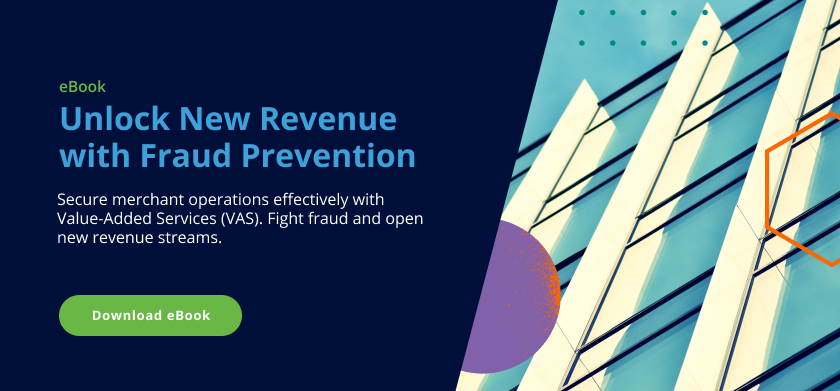Acquiring banks (also known as acquirers or merchant acquirers) are more than go-betweens for customers, merchants, and payment card schemes. They empower merchants to accept payments, settle the funds, transmit financial details to issuing banks for approval, and assume a share of risk for fraud and chargebacks. But like any other financial service acquiring banks are vulnerable to criminal activity. An acquiring bank must understand its merchant customers at a holistic level to prevent fraud effectively.
In this article, we’ll explore the role of acquiring banks in delivering safe, secure, and seamless commerce for businesses. We’ll also discuss the top challenges facing acquirers and the key pillars to providing a seamless merchant monitoring experience.
The Role of Acquiring Banks
An acquiring bank is a financial institution that empowers merchants to accept card payments (credit and debit) and other payment options from customers. When a transaction occurs, the bank is responsible for securely sending payment data across the payment ecosystem.
Additionally, they are responsible for addressing the transaction’s outcomes, depending on whether the issuing bank approves or denies it. In other words, acquiring banks are essential players that sit between customers, payment networks (Visa, Mastercard, etc.), card issuers, and the merchants themselves in the broader business ecosystem.
They can also do more than process card payments. They can also facilitate other payment types, such as cryptocurrency-based payments, bank-to-bank payments, and other methods customers want to use.
How Acquiring Banks Can Attract The Right Merchants
The rise of eCommerce opened up new opportunities for merchants to deliver exceptional services and attract new customers. An acquirer plays an essential role in helping merchants maximize revenue opportunities in the digital economy.
Critical services acquiring banks provide include:
- Increased sales conversion: Credit and debit cards are among the most popular payment methods currently available. However, understanding why these payments are approved or declined can be a dark art. Merchants can increase their bottom lines with greater insight into payment declines. For example, they can route transactions through the path of least resistance.
- Convenient Customer Experiences: Customers are more likely to patronize businesses that accept their preferred payment methods, whether they use credit cards, debit cards, digital wallets, or other payment types. Making it easier for customers to pay using their preferred method helps build merchant loyalty and boost customer satisfaction.
- Faster Cash Flow: Acquiring banks can quickly settle funds into merchant accounts. With more rapid access to cash, merchants have greater control over their financial stability.
- An eCommerce Gateway: Acquiring banks can integrate with, or provide themselves, online payment gateways, enabling brick-and-mortar merchants to connect to make the leap to eCommerce. Customers can make payments using digital channels, including websites and mobile apps.
- Ongoing Compliance: Merchant acquirers stay updated on new payment regulations and standards issued by card networks. Providing enhanced guidance via a consultative approach to merchants helps ensure they remain compliant with shifting rules and regulations and increases loyalty.
The State of Acquiring Banks
Fast access to cash is the lifeblood of any merchant. Merchants need easy access to money to pay vendors and suppliers, keep the lights on, and pay their employees on time.
Unfortunately, many merchants suffer from a cash flow crunch, forcing them to wait 7-14 days after payment processing for a transaction’s funds to settle. These days or even weeks-long payout lags are quickly becoming outdated. Same-day settlements (payouts) are becoming the norm in some global markets.
Many merchants are learning that existing acquiring solutions aren’t well-suited for these demands. Some merchants need fast access for operational expenditure. However, these services are often limited to merchants with a long and good history with their acquirers. Meanwhile, many acquirers struggle to provide an aggregated view of merchant risk, meaning some fraud warnings go undetected.
4 Common Fraud Threats for Acquiring Banks
Acquiring banks are essentially sponsors or endorsers of businesses when they onboard them into the digital payments ecosystem. In this capacity, they assume the risk for the financial well-being of the merchants in their portfolios.
Like many other financial services, acquiring banks are vulnerable to abuse by criminals and fraudsters. Acquirers could face significant financial losses for various fraudulent activities. Some of the most common types of acquiring fraud that impact businesses include:
Bust-out Fraud
Bust-out fraud is one of the most troublesome types of fraud for acquirers. Fraudsters create fake businesses and onboard with an acquiring bank. Once onboarded, they process stolen payment information and disappear before the payments are charged back. Acquirers are left to foot the bill.
In some cases, the fake business may look to build up a good history with the acquiring bank, only to process fraudulent payments later. This makes it even harder to detect potential illicit activity.
Card-Not-Present Fraud
Fraudsters steal or obtain stolen credit or debit card information compromised through data breaches. They use this information to make unauthorized card transactions online, by phone, or by mail. The fraudulent card transaction could go through if the merchant still needs to implement 3D Secure (3DS) authentication measures to require additional authentication.
Collusion Fraud
Collusion is another fraud threat that persistently dogs acquirers. As its name suggests, this type of fraud involves two or more parties—the seller and the buyer—colluding to defraud the acquiring bank.
A fraudulent merchant might list a fake or non-existent item on their marketplace while their accomplice knowingly “buys” it. The phony seller then cashes out the money from the purchase, forcing the acquirer to refund the money to the buyer and incur a fee. This type of fraud is also a gateway for money laundering, allowing criminals to funnel the profits from their illegal activities into legitimate banking systems by pretending to buy goods.
First-party Misuse
In first-party misuse, legitimate customers make purchases and receive their goods but falsely claim they never received them. The customer keeps the item and files for a chargeback, ultimately getting the items for free.
First-party misuse is especially difficult because it requires merchants (and acquirers, by extension) to distrust their own customers. It is also known as first-party fraud. Another phrase, “friendly fraud,” is gradually being phased. After all, what’s so friendly about fraud?
Feedzai’s 3 Pillars to Holistic Merchant Monitoring
Acquiring banks assume the risk for the merchants in their portfolios. To avoid severe losses, acquirers need a holistic view of merchant risk. Feedzai uses three key pillars to give acquiring banks a comprehensive understanding of a merchant’s risk profile.
These pillars include:
1. Onboarding Profiles vs. Current Merchant Activity
Onboarding is one of the most delicate stages in the relationship between acquiring banks and merchants. At this stage, acquirers get a sense of a merchant’s profile and the risk levels they can expect. Therefore, it’s vital that the merchant’s most recent behavior aligns with the profile they initially presented.
Significant deviations from the merchant’s onboarding profile can raise alarms for acquiring banks. Review the information provided by the merchant during the onboarding process. Feedzai’s solution helps acquiring banks understand if a merchant’s risk profile has changed significantly by analyzing whether the merchant’s activity since onboarding matches the provided information.
- Red Flag: A merchant who operates a bookstore suddenly starts selling high-risk items like CPD products. Significant shifts in the merchant’s profile indicate fraudulent or criminal activity and require a new risk assessment.
2. Recent Merchant Behavior vs. Historical Behavior
Acquirers must be mindful of criminals who either target merchants for their schemes or pose as legitimate merchants. Some criminals are notoriously patient in their fraud attempts. They may onboard with an acquirer and generally transact over several months or even years.
The longer these compromised or fake merchants transact, the more trust they can build. Once they have established a solid positive track record, they may commit a bust-out fraud or be involved in some collusion. In other words, criminals’ patience pays off by enabling them to profit from a deceptive history of good or apparently “normal” behavior.
Avoiding scenarios like bust-out fraud or collusion requires checking how merchant behavior is shifting. Our second pillar helps acquirers investigate if the merchant’s recent activity has shifted radically in the past three months.
- Red Flag: A sudden sharp rise in chargebacks or sales could indicate that fraudsters are targeting the merchant or that criminals are exploiting the merchant for nefarious purposes.
3. Compare to Similar Merchants
If all goes well, a merchant’s behavior should not be shocking. It should match or fall in line with that of other merchants in similar trades. Bakeries should behave like bakeries, coffee shops should behave like coffee shops, marketplaces should behave like marketplaces, and so on.
Of course, every merchant will have its own unique brand and style. These distinguishing traits are crucial to standing apart from competitors in a crowded market. However, significant deviations in the merchant’s size, industry, location, and other factors should give acquirers pause.
Feedzai’s final pillar helps acquirers understand how the merchant’s behavior matches that of other merchants with a similar profile. Consider factors like average transaction amount, volume, or chargeback rates.
- Red Flag: Significant deviations from peer merchant profiles could suggest suspicious activity that deserves closer investigation.
These three pillars of merchant risk monitoring should not be performed in isolation. Instead, they should be conducted together to understand how a merchant’s risk profile is shifting and whether their risk score should change. By considering all three pillars simultaneously, acquiring banks can more efficiently respond to alerts.
Keeping the Future of Commerce Secure
Acquiring banks are the critical link between merchants and the broader financial ecosystem. Assuming risk is part of acquirers’ duties—and criminals are looking to exploit this relationship to their advantage.
Feedzai’s three pillars of holistic merchant monitoring can give acquirers a clear view of the risks the merchants in their portfolios present. Understanding how a merchant’s profile and behaviors change is critical for acquirers to avoid unnecessary losses. With these pillars, acquirers can quickly identify shifts in merchant risk and respond quickly to avoid taking on unnecessary losses.
Share this article:
James Hunt
James Hunt has over 20 years of experience preventing payment fraud across banking, eCommerce, and payment service providers, specializing in creating, leading, and refining fraud prevention teams. Believing that fraud and risk teams should be an enabler of business and not a bottleneck, he’s consulted with some of the world's largest global brands. Prior to joining Feedzai, James held positions at NatWest, GoCardless, and Visa.
Related Posts
0 Comments4 Minutes
Feedzai’s AI Technology Earns Industry Recognition by Chartis
Feedzai, the world’s first RiskOps platform, has secured a pair of critical recognitions…
0 Comments6 Minutes
10 Fraud Prevention Tips for Businesses
Hopefully, you’ve had a chance to read Feedzai’s James Hunt’s insightful conversation…
0 Comments7 Minutes
Beyond the Face: Why Vietnam’s Banks Need Behavioral Biometrics to Fight the Rising Tide of Fraud
Financial transactions are increasingly virtual in today’s digital age, making fraud…

